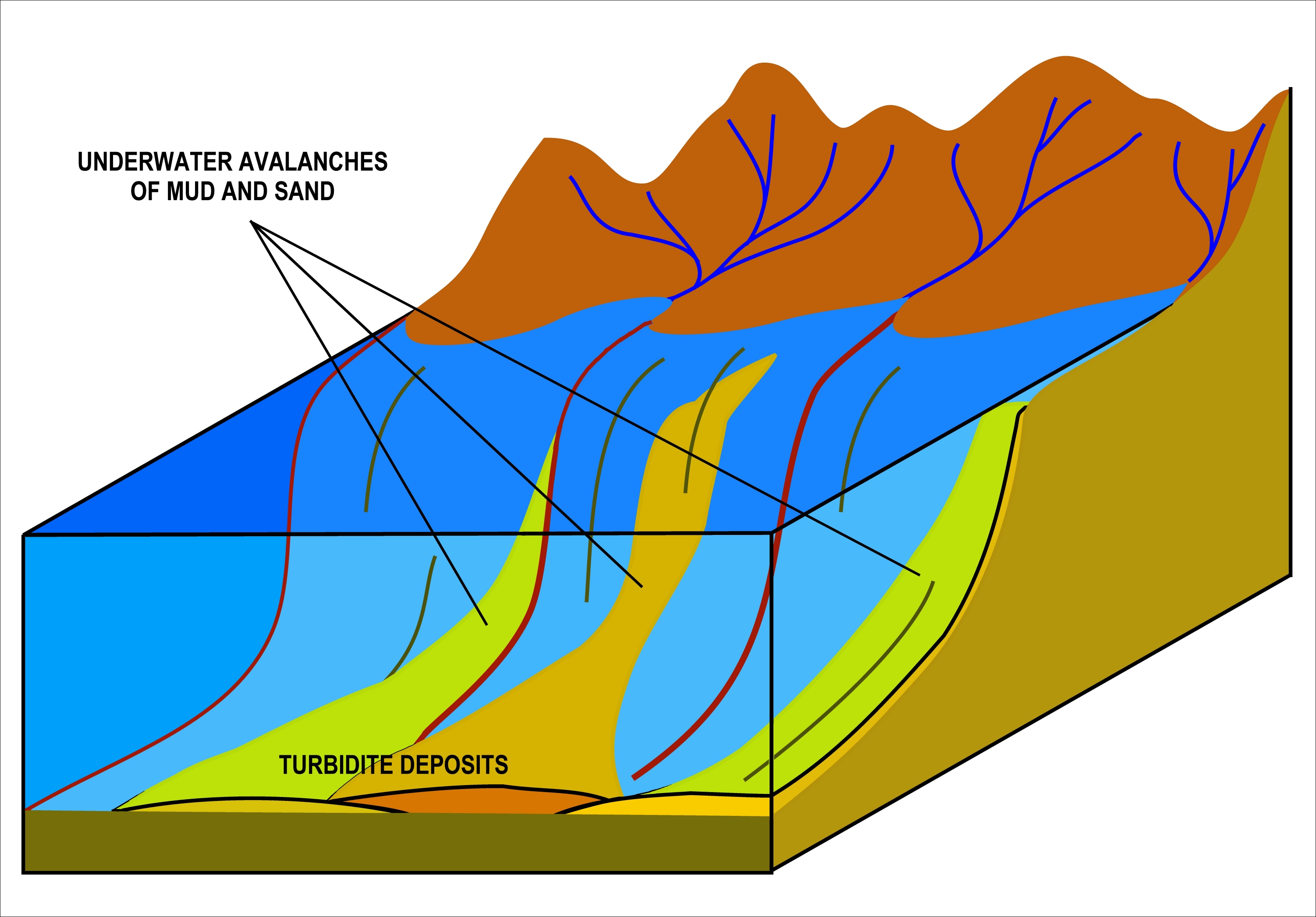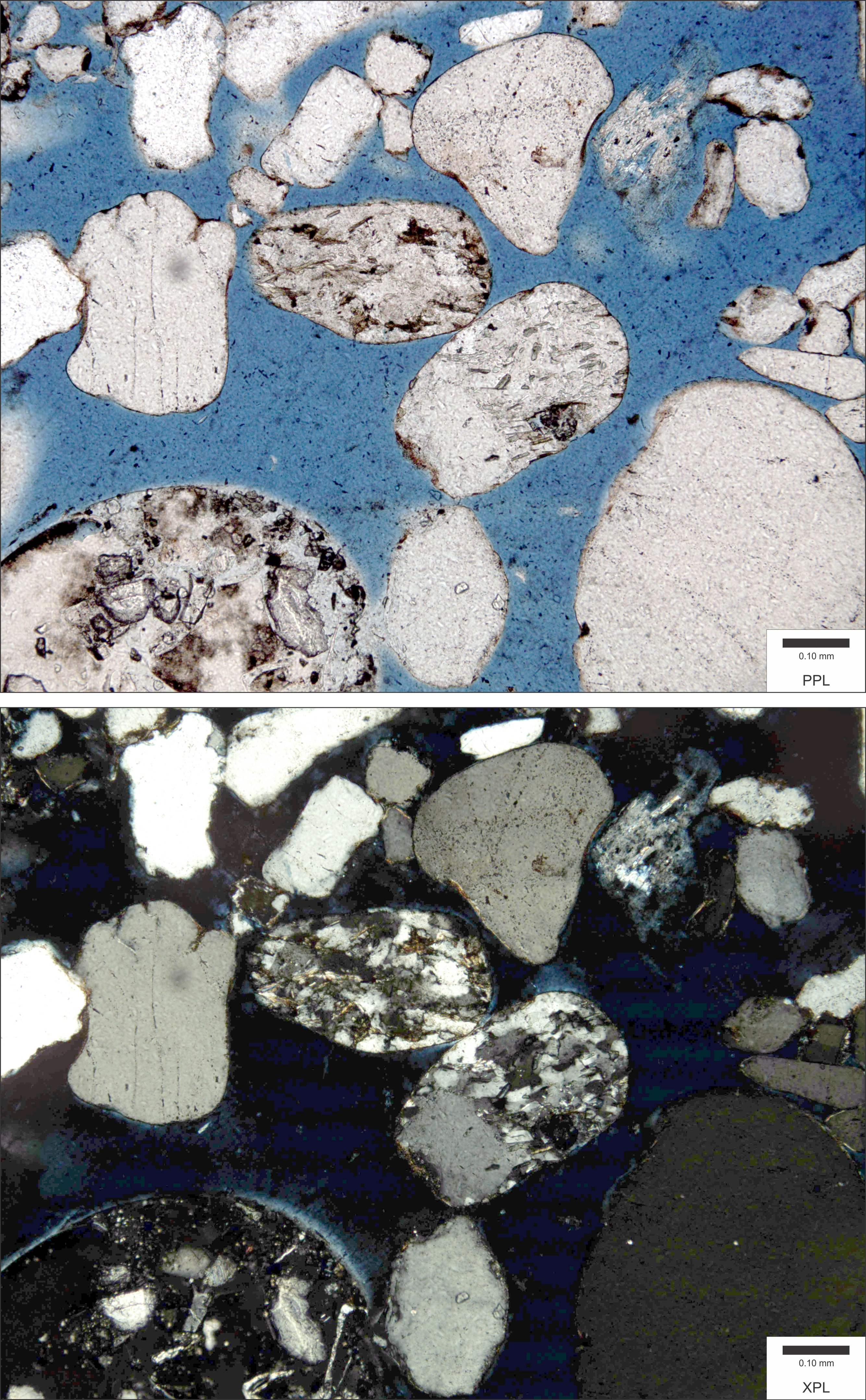|
Allyn River Member
The Allyn River Member is a geologic member in the New England Orogen in eastern Australia. Seen in the Hunter River region near Dungog, this stratum is up to 1,000 metres thick, though 740 metres thick at its type locality. Formed in the Visean between 346.7 and 330.9 Ma., it is part of the Flagstaff Formation of sedimentary rocks. This stratigraphic unit includes green to brown, medium thickly bedded lithic sandstone with turbiditic sedimentary structures and interbeds of brown thinly bedded mudstone Mudstone, a type of mudrock, is a fine-grained sedimentary rock whose original constituents were clays or muds. Mudstone is distinguished from ''shale'' by its lack of fissility.Blatt, H., and R.J. Tracy, 1996, ''Petrology.'' New York, New York, ....Roberts, J., Engel, B., Lennox, M., Chapman, J., 1991, Dungog, New South Wales 1:100 000 Geological Sheet 9233, Geological Survey of New South Wales. 1:100,000 geological sheet series, 1v, Map See also * New England Orogen ... [...More Info...] [...Related Items...] OR: [Wikipedia] [Google] [Baidu] |
Viséan
The Visean, Viséan or Visian is an age in the ICS geologic timescale or a stage in the stratigraphic column. It is the second stage of the Mississippian, the lower subsystem of the Carboniferous. The Visean lasted from to Ma. It follows the Tournaisian age/stage and is followed by the Serpukhovian age/stage. Name and definitions The Viséan Stage was introduced by Belgian geologist André Dumont in 1832. Dumont named this stage after the city of Visé in Belgium's Liège Province. Before being used as an international stage, the Viséan Stage was part of the (West) European regional geologic time scale, in which it followed the Tournaisian Stage and is followed by the Namurian Stage. In the North American regional scale, the Viséan Stage correlates with the upper Osagean, the Meramecian and lower Chesterian stages. In the Chinese regional time scale, it correlates with the lower and middle Tatangian series.; 2006: ''Global time scale and regional stratigraphic ... [...More Info...] [...Related Items...] OR: [Wikipedia] [Google] [Baidu] |
Turbidite Deposits
A turbidite is the geologic deposit of a turbidity current, which is a type of amalgamation of fluidal and sediment gravity flow responsible for distributing vast amounts of clastic sediment into the deep ocean. Sequencing Turbidites were first properly described by Arnold H. Bouma (1962), who studied deepwater sediments and recognized particular "fining-up intervals" within deep water, fine-grained shales, which were anomalous because they started at pebble conglomerates and terminated in shales. This was anomalous because within the deep ocean it had historically been assumed that there was no mechanism by which tractional flow could carry and deposit coarse-grained sediments into the abyssal depths. Bouma cycles begin with an erosional contact of a coarse lower bed of pebble to granule conglomerate in a sandy matrix, and grade up through coarse then medium plane parallel sandstone; through cross-bedded sandstone; rippled cross-bedded sand/silty sand, and finally laminar ... [...More Info...] [...Related Items...] OR: [Wikipedia] [Google] [Baidu] |
Sandstone Formations
Sandstone is a clastic sedimentary rock composed mainly of sand-sized (0.0625 to 2 mm) silicate grains, cemented together by another mineral. Sandstones comprise about 20–25% of all sedimentary rocks. Most sandstone is composed of quartz or feldspar, because they are the most resistant minerals to the weathering processes at the Earth's surface. Like uncemented sand, sandstone may be imparted any color by impurities within the minerals, but the most common colors are tan, brown, yellow, red, grey, pink, white, and black. Because sandstone beds can form highly visible cliffs and other topographic features, certain colors of sandstone have become strongly identified with certain regions, such as the red rock deserts of Arches National Park and other areas of the American Southwest. Rock formations composed of sandstone usually allow the percolation of water and other fluids and are porous enough to store large quantities, making them valuable aquifers and petroleum ... [...More Info...] [...Related Items...] OR: [Wikipedia] [Google] [Baidu] |
Carboniferous System Of Australia
The Carboniferous ( ) is a geologic period and system of the Paleozoic era that spans 60 million years, from the end of the Devonian Period Ma (million years ago) to the beginning of the Permian Period, Ma. It is the fifth and penultimate period of the Paleozoic era and the fifth period of the Phanerozoic eon. In North America, the Carboniferous is often treated as two separate geological periods, the earlier Mississippian and the later Pennsylvanian. The name ''Carboniferous'' means "coal-bearing", from the Latin ("coal") and ("bear, carry"), and refers to the many coal beds formed globally during that time. The first of the modern "system" names, it was coined by geologists William Conybeare and William Phillips in 1822, based on a study of the British rock succession. Carboniferous is the period during which both terrestrial animal and land plant life was well established. Stegocephalia (four-limbed vertebrates including true tetrapods), whose forerunners (tetrapodomor ... [...More Info...] [...Related Items...] OR: [Wikipedia] [Google] [Baidu] |
Bed (geology)
In geology, a bed is a layer of sediment, sedimentary rock, or volcanic rock "bounded above and below by more or less well-defined bedding surfaces".Neuendorf, K.K.E., J.P. Mehl, Jr., and J.A. Jackson, eds., 2005. ''Glossary of Geology'' (5th ed.). Alexandria, Virginia; American Geological Institute. p 61. A bedding surface or bedding plane is respectively a curved surface or Euclidean planes in three-dimensional space, plane that visibly separates each successive bed (of the same or different lithology) from the preceding or following bed. In Cross section (geology), cross sections, bedding surfaces or planes are often called bedding contacts. Within conformable successions, each bedding surface acted as the depositional surface for the accumulation of younger sediment. Definitions Specifically in sedimentology, a bed can be defined in one of two major ways.Davies, N.S., and Shillito, A.P. 2021, ''True substrates: the exceptional resolution and unexceptional preservation of de ... [...More Info...] [...Related Items...] OR: [Wikipedia] [Google] [Baidu] |
Turbiditic
A turbidity current is most typically an underwater current of usually rapidly moving, sediment-laden water moving down a slope; although current research (2018) indicates that water-saturated sediment may be the primary actor in the process. Turbidity currents can also occur in other fluids besides water. Researchers from the Monterey Bay Aquarium Research Institute found that a layer of water-saturated sediment moved rapidly over the seafloor and mobilized the upper few meters of the preexisting seafloor. Plumes of sediment-laden water were observed during turbidity current events but they believe that these were secondary to the pulse of the seafloor sediment moving during the events. The belief of the researchers is that the water flow is the tail-end of the process that starts at the seafloor. In the most typical case of oceanic turbidity currents, sediment laden waters situated over sloping ground will flow down-hill because they have a higher density than the adjacen ... [...More Info...] [...Related Items...] OR: [Wikipedia] [Google] [Baidu] |
Lithic Sandstone
Lithic sandstones, or lithic arenites, or litharenites, are sandstones with a significant (>5%) component of lithic fragments, though quartz and feldspar are usually present as well, along with some clayey matrix. Lithic sandstones can have a speckled (salt and pepper) or gray color, and are usually associated with one specific type of lithic fragment (i.e., igneous, sedimentary, or metamorphic).Prothero, D. R. and Schwab, F., 1996, Sedimentary Geology, pg. 100, Tectonically, lithic sandstones often form in a wide variety sedimentary depositional environments (including fluvial, deltaic, and alluvial sediments) associated with active margins. This tectonic Tectonics ( via Latin ) are the processes that result in the structure and properties of the Earth's crust and its evolution through time. The field of ''planetary tectonics'' extends the concept to other planets and moons. These processes ... setting provides the source of the lithic fragments, either through ... [...More Info...] [...Related Items...] OR: [Wikipedia] [Google] [Baidu] |
Stratigraphic Unit
A stratigraphic unit is a volume of rock of identifiable origin and relative age range that is defined by the distinctive and dominant, easily mapped and recognizable petrographic, lithologic or paleontologic features ( facies) that characterize it. Units must be ''mappable'' and ''distinct'' from one another, but the contact need not be particularly distinct. For instance, a unit may be defined by terms such as "when the sandstone component exceeds 75%". Lithostratigraphic units Sequences of sedimentary and volcanic rocks are subdivided on the basis of their shared or associated lithology. Formally identified lithostratigraphic units are structured in a hierarchy of lithostratigraphic rank, higher rank units generally comprising two or more units of lower rank. Going from smaller to larger in rank, the main lithostratigraphic ranks are bed, member, formation, group and supergroup. Formal names of lithostratigraphic units are assigned by geological surveys. Units of form ... [...More Info...] [...Related Items...] OR: [Wikipedia] [Google] [Baidu] |
Megaannus
A year is a unit of time based on how long it takes the Earth to orbit the Sun. In scientific use, the tropical year (approximately 365 solar days, 5 hours, 48 minutes, 45 seconds) and the sidereal year (about 20 minutes longer) are more exact. The modern calendar year, as reckoned according to the Gregorian calendar, approximates the tropical year by using a system of leap years. The term 'year' is also used to indicate other periods of roughly similar duration, such as the lunar year (a roughly 354-day cycle of twelve of the Moon's phasessee lunar calendar), as well as periods loosely associated with the calendar or astronomical year, such as the seasonal year, the fiscal year, the academic year, etc. Due to the Earth's axial tilt, the course of a year sees the passing of the seasons, marked by changes in weather, the hours of daylight, and, consequently, vegetation and soil fertility. In temperate and subpolar regions around the planet, four seasons are generally recogn ... [...More Info...] [...Related Items...] OR: [Wikipedia] [Google] [Baidu] |
Dungog
Dungog is a country town on the Williams River in the Hunter region and a small part of the Mid North Coast region of New South Wales, Australia. Located in the middle of dairy and timber country, it is the centre of the Dungog Shire Local Government Area and at the 2021 Census it had a population of people. The area includes the Fosterton Loop, of road, used in the annual Pedalfest. A small portion of Dungog lies in the Mid-Coast Council Local Government Area. History The traditional owners of the area now known as Dungog are the Gringai clan of the Wonnarua people, a group of Aboriginal Australian people. By 1825 Robert Dawson had named the Barrington area, while surveyor Thomas Florance named the Chichester River in 1827. Two years later George Boyle White explored the sources of the Allyn and Williams rivers. Grants along the Williams followed to men such as Duncan Mackay, John Verge, James Dowling (later a NSW Chief Justice) and others, who, with their assigned ... [...More Info...] [...Related Items...] OR: [Wikipedia] [Google] [Baidu] |
Allyn River
Allyn River, a perennial stream of the Hunter River catchment, is located in the Hunter region of New South Wales, Australia. Course Allyn River rises on Allyn Range, on the slopes of the Gondwana Rainforests Barrington Tops, west of Careys Peak, and flows generally southeast, joined by seven minor tributaries, before reaching its confluence with the Paterson River near Vacy; descending over its course. The course of the river flows through World Heritage listed high elevation rainforest, noted for its Antarctic Beech; and then through lower elevation subtropical rainforest, including trees such as Red Cedar and Small leaf fig. Some of the River Oak growing beside the stream are over in height. Logging has been practiced in the area since the 1820s. In the middle course of the river, the geology includes sedimentary rocks such as the Allyn River Member. History The Allyn River valley is the traditional territory of the Gringai clan of the Wonnarua people, a group of ... [...More Info...] [...Related Items...] OR: [Wikipedia] [Google] [Baidu] |





